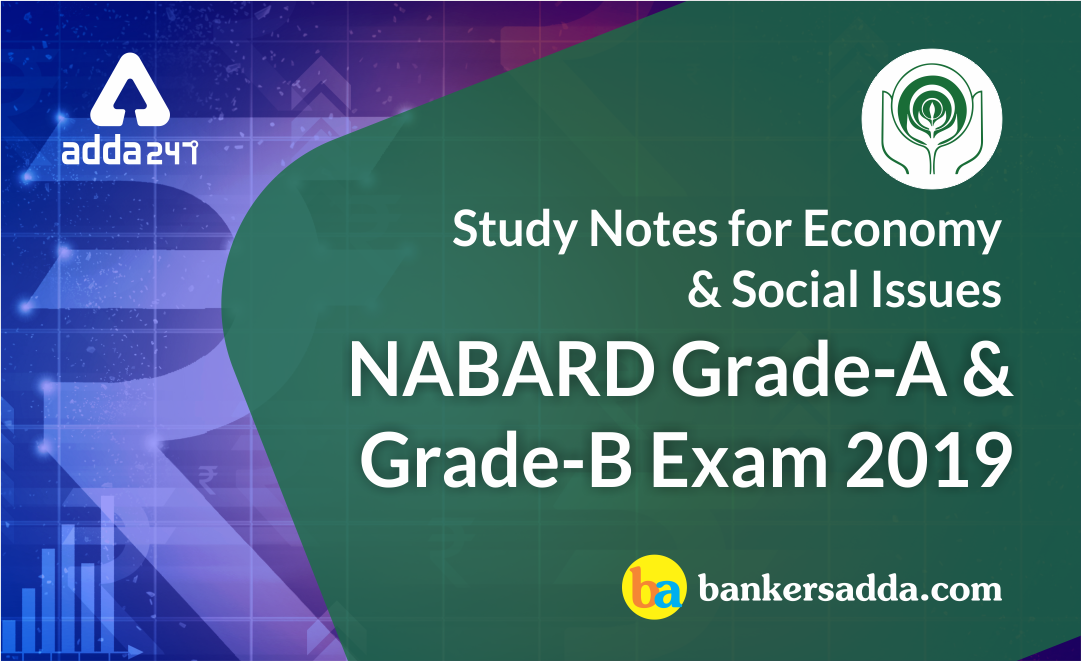NABARD Study Notes | Economic and Social Issues
Dear Aspirants, The upcoming important exams are NABARD Grade-A and Grade-B, in which there is a section of Economic and Social Issues. So, for the same, it becomes really important to have an in-depth knowledge of the various important topics given in the syllabus. To help you with this our experts today are providing you with all the necessary information related to the mentioned field which will help you to fetch some good marks.
The topics we are covering in this post are Chapter- 03 Measurement of Growth: National Income and Per Capita Income and Chapter- 04 Poverty Alleviation and Employment Generation in India. These notes would be very useful, so we request you to read it before you appear for the exam.
Chapter-03
Measurement of Growth: National Income and Per Capita Income
Economic growth is an increase in the production of goods and services over a specific period. To be most accurate, the measurement must remove the effects of inflation. Economic growth creates more profit for businesses. As a result, stock prices rise. That gives the company’s capital to invest and hire more employees. As more jobs are created, incomes rise. Consumers have more money to buy additional products and services. Purchases drive higher economic growth. For this reason, all countries want positive economic growth. This makes economic growth the most watched economic indicator.
Gross Domestic Product-
Gross domestic product is the logical extension of measuring economic growth in terms of monetary expenditures. If a statistician wants to understand the productive output of the steel industry, for example, he needs only to track the dollar value of all of the steel that entered the market during a specific period.
Combine the outputs of all industries, measured in terms of dollars spent or invested, and you get total production. At least that was the theory. Unfortunately, the tautology that expenditures equal sold-production does not actually measure relative productivity. The productive capacity of an economy does not grow because more dollars move around; an economy becomes more productive because resources are used more efficiently. In other words, economic growth needs to somehow measure the relationship between total resource inputs and total economic outputs.
The OECD itself described GDP as suffering from a number of statistical problems. Its solution was to use GDP to measure aggregate expenditures, which theoretically approximate the contributions of labor and output, and to use multi-factor productivity (MFP) to show the contribution of technical and organizational innovation.
Gross National Product-
Those of a certain age may remember learning about the gross national product (GNP) as an economic indicator. Economists use GNP mainly to learn about the total income of a country’s residents within a given period and how the residents use their income. GNP measures the total income accruing to the population over a specified amount of time. Unlike gross domestic product, it does not take into account income accruing to non-residents within that country’s territory; like GDP, it is only a measure of productivity, and it is not intended to be used as a measure of the welfare or happiness of a country.
National Income: National income is the total value a country’s final output of all new goods and services produced in one year.
Per Capita Income as a Measure of Development:
Per capita income is more generally used as a measure of development and is considered as better indicator of the development as the increase in per capita income shows the ability of a country to increase its gross domestic product (GDP) faster than population. Increase in per capita income indicates the overall improvement in the economic well-being of a population, that is, it shows how much extra goods and services are available per head in a country for consumption and investment. It is, however, worthwhile to note that it is real per capita income that is used to measure level of development and therefore growth or development was measured by the increase in real per capita income in a period. The increase in real per capita income is found by adjusting nominal per capita income for the rate of inflation.
The Income Method:
The people of a country who produce GDP during a year receive incomes from their work. Thus GDP by income method is the sum of all factor incomes: Wages and Salaries (compensation of employees) + Rent + Interest + Profit.
3. Expenditure Method:
This method focuses on goods and services produced within the country during one year.
GDP by expenditure method includes:
(1) Consumer expenditure on services and durable and non-durable goods (C),
(2) Investment in fixed capital such as residential and non-residential building, machinery, and inventories (I),
(3) Government expenditure on final goods and services (G),
(4) Export of goods and services produced by the people of the country (X),
(5) Less imports (M). That part of consumption, investment and government expenditure which is spent on imports is subtracted from GDP. Similarly, any imported component, such as raw materials, which is used in the manufacture of export goods, is also excluded.
Thus GDP by expenditure method at market prices = C+ I + G + (X – M), where (X-M) is net export which can be positive or negative.
Net Domestic Product (NDP):
NDP is the value of the net output of the economy during the year. The value of this capital consumption is some percentage of gross investment which is deducted from GDP. Thus Net Domestic Product = GDP at Factor Cost – Depreciation.
Final Goods
Final goods are goods that are ultimately consumed rather than used in the production of another good.
Differences between GDP and GNP
The two are related. The difference is that GNP includes net foreign income. GNP adds net foreign investment income compared to GDP. GDP shows how much is produced within the boundaries of the country by both the citizens and the foreigners. It is the market value of all the output produced in the territory of a nation in one year. In contrast, GNP is a measure of the value of the output produced by the “nationals” of a country- both with-in the geographical boundaries and outside.
NNP = GNP – Depreciation
National Income is calculated by deducting indirect taxes from Net National Product and adding subsidies. National Income (NI) is the NNP at factor cost.
NI = NNP – Indirect Taxes + Subsidies
India’s per capita income grows by 8.60% to Rs 1.13 lakh in Financial Year 2018. India’s per capita income grew at a slower pace of 8.6 percent to Rs 1,12,835 during the fiscal ended March 2018, official data showed in May 2018. The per capita net national income in 2016-17 stood at Rs 1,03,870, witnessing a growth of over 10.3 percent from the preceding fiscal ended March 2016 (at Rs 94,130).
“The per capita income at current prices during 2017-18 is estimated to have attained a level of Rs 1,12,835 as compared to the estimates for the year 2016-17 of Rs 1,03,870, showing a rise of 8.6 per cent,” showed the provisional estimates of annual income, 2017-18 released by the Ministry of Statistics and Programme Implementation (MOSPI).
The per capita income is a crude indicator of the prosperity of a country. In real terms, calculated at constant prices with base 2011-12, the per capita income grew by 5.4 percent to Rs 86,668 in 2017-18 as compared to Rs 82,229 in 2016-17. “The growth rate in per capita income is estimated at 5.4 percent during 2017-18, as against 5.7 percent in the previous year,” the release stated.
The country’s gross national income (GNI) at current prices witnessed a rise of about 10 percent at Rs 165.87 lakh crore during 2017-18 as against Rs 150.77 lakh crore during 2016-17. While on real terms (with the 2011-12 base year), the GNI increased at a slower rate of 6.7 percent to Rs 128.64 lakh crore in fiscal ended March 2018, as against the previous year’s estimate of Rs 120.52 lakh crore. For fiscal ended March 2017, the real term GNI grew by 7.1 percent.
Chapter-04
Poverty Alleviation and Employment Generation in India
Poverty and Employment Generation is one of the most significant goals of growth approach since the initiation of planning in India. The concept of sustainable economic growth that implies progressive changes in the socio-economic formation of a country or society in terms of eradicating poverty, and unemployment and also inequality, illiteracy, malnutrition has been accepted as a proper intention to desire for. Anti-poverty and employment generation programs are implementing a proper way to eradicate poverty and increasing employment generation. The present study uses the concept of “poverty and employment generation” to address the problems of poverty and employment generation in all state wise in India.
The study analysis the state wise percentage of population below the poverty line, and to understand the number of poor and poverty ration of measured by the Rangarajan committee and Tendulkar committee. The study analysis the growth of employment generation in the economic sector, unemployment ratio and status of absolute employment ratio in major states and also poverty alleviation programmes in India This study is purely based on secondary data sources from ministry of labour and employment Govt. of India, Planning commission report and etc. The analysis will be done using appropriate statistical tools and techniques.
Poverty reduction has been an important goal of development policy since the inception of planning in India. Various antipoverty, employment generation and basic services programmes have been in operation for decades in India.
Anti-poverty, employment generation and basic services programmes-
(a) Pradhan Mantri Gram Sadak Yojana (PMGSY)-
Launched in December 2000 as a 100 percent CSS, PMGSY aims to provide all-weather connectivity to all the eligible unconnected rural habitations. Bharat Nirman envisages connectivity by 2009 to all the habitations with a population of 1000 or more in the plains, and of 500 or more in the hilly, desert and tribal areas. The systematic up-gradation of the existing rural road network also is an integral component of the scheme, funded mainly from the accruals of diesel cess in the Central Road Fund, with support of the multilateral funding agencies and the domestic financial institutions. Up to December 2005, with an expenditure of Rs.12,049 crore, a total length of 82,718 km. of road works had been completed.
(b) Indira Awaas Yojana (IAY)-
IAY aims to provide dwelling units, free of cost, to the Scheduled Castes (SCs), Scheduled Tribes (STs), and freed bonded labourers, and also the non-SC/ST BPL families in rural areas. It is funded on a cost-sharing basis in the rates of 75.25 between the Centre and the States. To address these gaps in the rural housing program and in view of Government’s commitment to providing “Housing for All’’ by the scheme 2022, the of has IAY has been re-structured into Pradhan Mantri Awaas Yojana –Gramin (PMAY-G) w.e.f. 1st April 2016.
(c) Swarnjayanti Gram Swarozgar Yojana (SGSY)-
SGSY, launched in April 1999 after restructuring the Integrated Rural Development Programme and allied schemes, is the only self-employment programme for the rural poor. The objective is to bring the self-employed above the poverty line by providing them income generating assets through bank credit and Government subsidy.
(d) Sampoorna Grameen Rozgar Yojana (SGRY)-
SGRY, launched on September 25, 2001, to provide additional wage employment in the rural areas, has a cash and food grains component, and the Centre bears 75 percent and 100 percent of the cost of the two with the balance borne by the States/UTs.
(e) National Food for Work Programme (NFFWP)
The NFFWP was launched as a CSS in November 2004 in the 150 most backward districts to generate additional supplementary wage employment with food security. States receive food grains under NFFWP free of cost. The focus of the programme is on works relating to water conservation, drought proofing (including aforestation /tree plantation), land development, flood-control/protection (including drainage in waterlogged areas), and rural connectivity in terms of all-weather roads.
(g) Swarna Jayanti Shahari Rozgar Yojana (SJSRY)-
In December 1997, the Urban Self-Employment Programme (USEP) and the Urban Wage Employment Programme (UWEP), which are the two special components of the SJSRY, substituted for various programmes operated earlier for urban poverty alleviation. The SJSRY is funded on a 75:25 basis between the Centre and the States
Govt. aims to remove poverty by 2032-
Transforming India, an ambitious action plan finalised after two months of brainstorming shepherded by Prime Minister Narendra Modi has recommended a slew of reforms to be implemented by ministries and departments if India has to grow by 10 percent per annum until 2032. This, according to the action plan, will totally eradicate poverty from India in the next 16 years and also create 175 million new jobs.
“Growing at 10 percent will transform India – India will be a $10 trillion economy with no poverty in 2032,” the plan states. In 2015-16, the size of the Indian economy was a little over $2 trillion and the gross domestic product growth was around 7.6 percent. As part of first steps in this grand plan, the government has set out to implement WTO-compatible procurement norms by 2017-18, achieve 100 per cent rural electrification by May 2018, increase rural teledensity to 100 per by 2020, reach broadband connectivity through optical fibre to all gram panchayats by December 2018 and have 175 million broadband connections by 2017.
The centre identified eight themes and decided to constitute eight groups of secretaries to come out with recommendations and a road map for each of the themes. The objective of the action plan was to foster development but with inclusive growth and efficiency. According to a secretary, the PM was happy with the finalised action plan. He told the secretaries that no expert group could have made such recommendations because these have come from people who think the plan is doable.
Center’s Action Plan for Transforming India-
- Seeding of Aadhaar number in 90% ration cards by March 2017
- Increase rural teledensity to 100% by 2020
- 175 million broadband connections by 2017
- Deregulation of genetically engineered (Bt) insect-resistant pulses by March 2018
- WTO-compatible procurement norms by March 2018
- Third-party scrutiny of road project execution agencies by end of 2016
- VC funds for start-ups by end of 2016
- PAN mandatory for all businesses – to serve as unique business identifier by March 2017






 GA Capsule for SBI Clerk Mains 2025, Dow...
GA Capsule for SBI Clerk Mains 2025, Dow...
 The Hindu Review October 2022: Download ...
The Hindu Review October 2022: Download ...
 30 Days Study Plan to Crack SBI Clerk 20...
30 Days Study Plan to Crack SBI Clerk 20...





